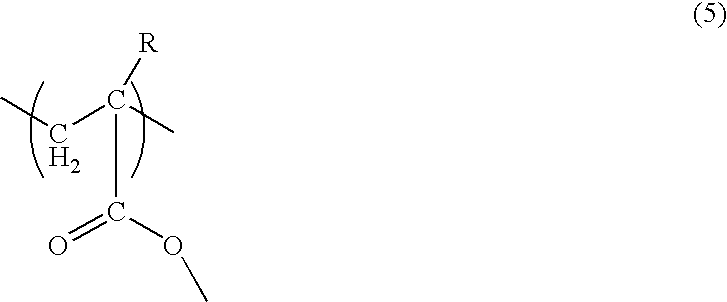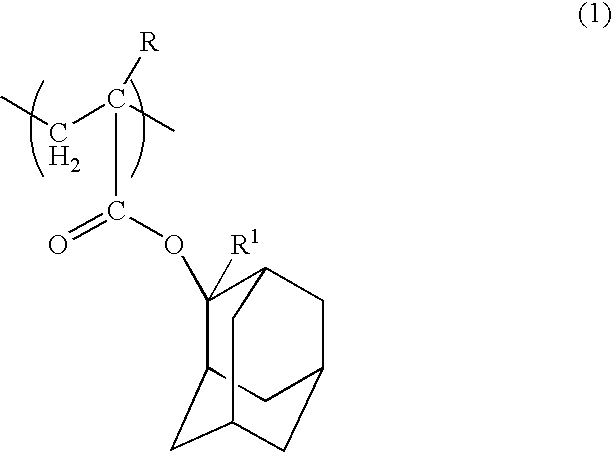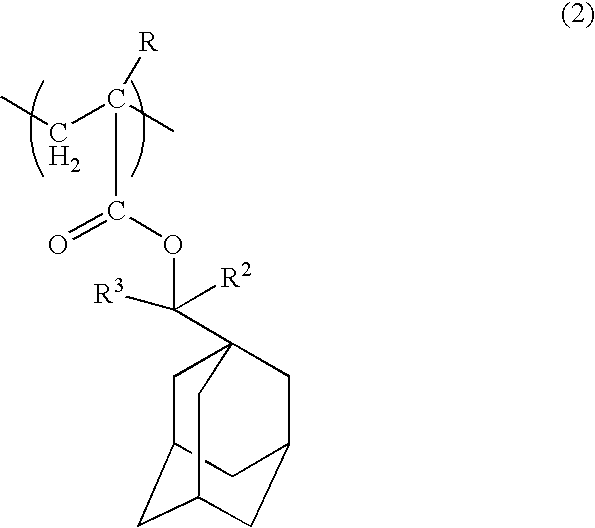Positive resist composition and method of forming resist pattern
a composition and resist technology, applied in the field of chemical amplifying positive type resist composition, can solve the problems of unsatisfactory depth of focus range of this type of isolated resist pattern, proximity effect problem, unsuitable for use in such processes, etc., and achieve the effect of suppressing any proximity effect, improving the depth of focus range of an isolated resist pattern, and excellent resolution
- Summary
- Abstract
- Description
- Claims
- Application Information
AI Technical Summary
Benefits of technology
Problems solved by technology
Method used
Image
Examples
example 1
[0047]First, for the resin component (A), 100 parts by mass of a copolymer of the units represented by each of structural formulas (14) to (17) shown below was prepared. The proportions of each of the units represented by the structural formulas (14) to (17) within the copolymer were set to 35 mol % for the unit represented by the structural formula (14), 35 mol % for the unit represented by the structural formula (15), 15 mol % for the unit represented by the structural formula (16), and 15 mol % for the unit represented by the structural formula (17). The weight average molecular weight of this copolymer was 10,000.
[0048]Furthermore, for the acid generator component (B), 2 parts by mass of triphenylsulfonium nonafluorobutanesulfonate was prepared, for the tertiary lower aliphatic amine (D), 0.2 parts by mass of triethanolamine was prepared, and for the organic solvent (C), a mixed solvent formed from 750 parts by mass of propylene glycol monomethyl ether acetate and 30 parts by ma...
example 2
[0060]A copolymer was produced as the resin component (A), using each of the units of the structural formula (14), the structural formula (15) and the structural formula (16) from Example 1, as is, but replacing the unit of the structural formula (17) with a unit of a structural formula (18) shown below, and 100 parts by mass of this copolymer were prepared. The proportions of each of the units within the copolymer were set to the same values as Example 1 for the units of the structural formula (14), the structural formula (15) and the structural formula (16), whereas the proportion of the unit of the structural formula (18) was set at the same level as the unit of the structural formula (17) in Example 1. The weight average molecular weight of this copolymer was 10,000.
[0061]Outside of the resin component (A), preparation was conducted in the same manner as Example 1, yielding a uniform positive type resist solution (composition) as Example 2 of the present invention.
[0062]Subseque...
example 3
[0067]A copolymer was produced as the resin component (A), using each of the units of the structural formula (14), the structural formula (16) and the structural formula (18) from Example 2, as is, but replacing the unit of the structural formula (15) with a unit of a structural formula (19) shown below, and 100 parts by mass of this copolymer were prepared. The proportions of each of the units within the copolymer were set to the same values as Example 2 for the units of the structural formula (14), the structural formula (16) and the structural formula (18), whereas the proportion of the unit of the structural formula (19) was set at the same level as the unit of the structural formula (15) in Example 2. The weight average molecular weight of this copolymer was 10,000.
[0068]Outside of the resin component (A), preparation was conducted in the same manner as Example 1, yielding a uniform positive type resist solution (composition) as Example 3 of the present invention.
[0069]Subseque...
PUM
| Property | Measurement | Unit |
|---|---|---|
| wavelength | aaaaa | aaaaa |
| mass % | aaaaa | aaaaa |
| thickness | aaaaa | aaaaa |
Abstract
Description
Claims
Application Information
 Login to View More
Login to View More - R&D
- Intellectual Property
- Life Sciences
- Materials
- Tech Scout
- Unparalleled Data Quality
- Higher Quality Content
- 60% Fewer Hallucinations
Browse by: Latest US Patents, China's latest patents, Technical Efficacy Thesaurus, Application Domain, Technology Topic, Popular Technical Reports.
© 2025 PatSnap. All rights reserved.Legal|Privacy policy|Modern Slavery Act Transparency Statement|Sitemap|About US| Contact US: help@patsnap.com



